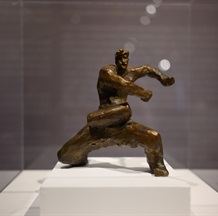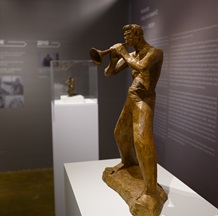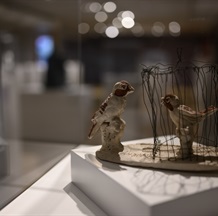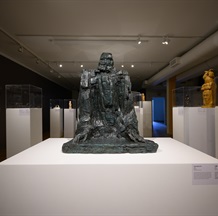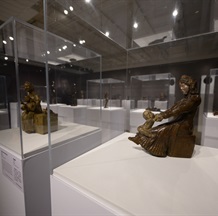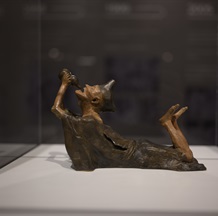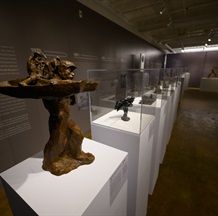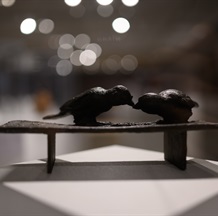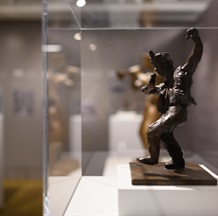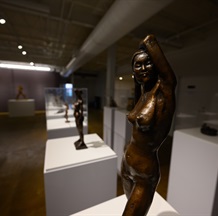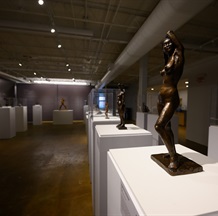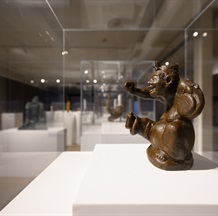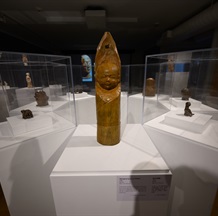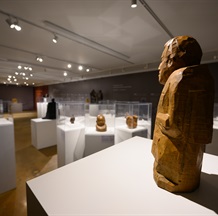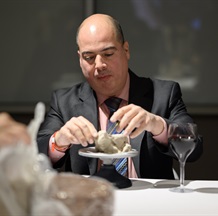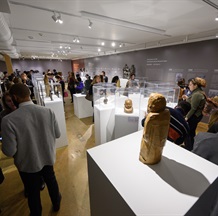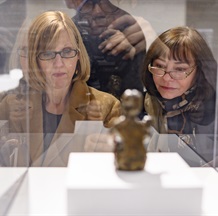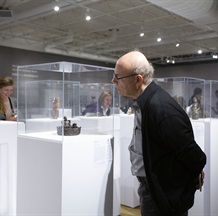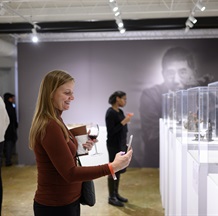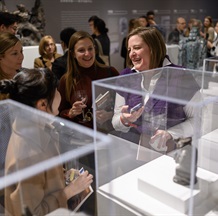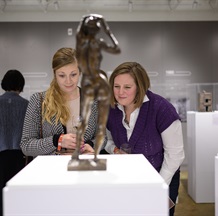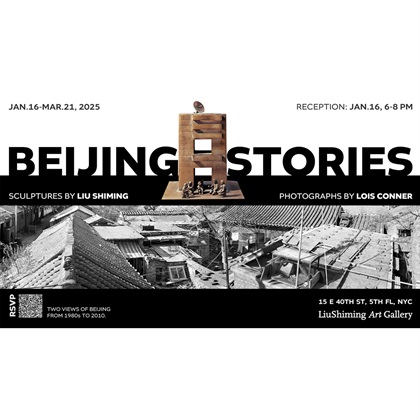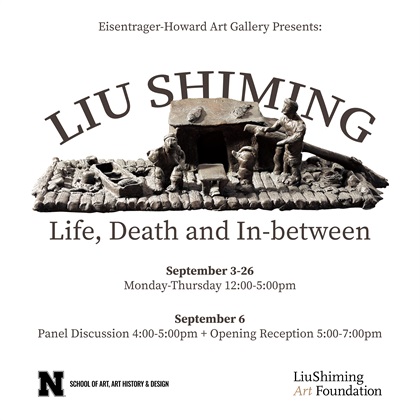
A Portrait Sculpture of Mr. Liu Shiming by Wang Shaojun, Deputy Party Secretary of CAFA and Academic Advisor of the Exhibition (CAFA)

Exhibition View
“I think that sculpture should be focused on people and the depiction of people, because people are social beings and creators of art. When we lose people and the human spirit, art loses its soul.”—Liu Shiming
On the afternoon of November 14, 2019, “Kindness Expresses Truth and Love: Liu Shiming’s Sculpture” was unveiled at the Asian Fusion Gallery in Washington, D.C.. This exhibition is the second stop of the Chinese Methods: Liu Shiming International Sculpture Tour, organized by the Central Academy of Fine Arts, with Wang Shaojun, Deputy Party Secretary of CAFA and sculptor, as the academic chair, and Hongmei, Associate Professor of CAFA, as the curator. 63 bronze and pottery sculptures cast by Liu Shiming during his lifetime were on display. The exhibition was divided into four academic sections: “The Meaning of Life: Artifact Study at the National Museum of Chinese History,” “The Essence of Life: An Innocent and an Innocent Heart,” “Real People: Life in the Ordinary World,” and “Ideal People: Joy in the Ordinary World.”
Compared with the first stop of exhibition, which systematically sorted out Liu Shiming’s individual and artistic experiences, “Kindness Expresses Truth and Love: Liu Shiming’s Sculpture” focused on the “humanistic spirit” that ran through all of Liu Shiming’s sculptures on various themes during each period. Viewers can also come to appreciate Liu Shiming’s sculpture language while observing the modernization that has taken place in the last one hundred years of Chinese sculpture, which has uniquely Chinese characteristics and is rooted in Chinese traditional and local experiences—this mode is entirely different from the modern Western narrative.



Exhibition view
The sociological significance of “man” in the Chinese context emphasizes kindness in interpersonal relationships. China’s classical cultural system was the first to stress the influence of kindness, which has continued to this day. Mencius once said, “Kindness expresses truth and love. Propriety shows respect to others.” (Mencius, Chapter 28). People should be kind and compassionate and treat others accordingly. The relationships between people should be full of friendship, love, and mutual respect. When Liu Shiming mentioned the “humanist spirit,” he was referring to the essence of humanism in Western classical culture. Since the maxim “Know thyself” was carved onto the door frame of the Temple of Apollo at Delphi during the heyday of ancient Greece, the sociological significance of “man” in the Western context has stressed self-knowledge, independence, and selfimprovement. In this context, interpersonal relationships emphasize respect for people as independent individuals. Liu Shiming saw people, art, “kindness expresses truth and love,” and the humanist spirit as the meaning of life and the spirit of art. With his unique “Chinese methods,” he loved people, especially ordinary people, and he loved people living real lives in the everyday world. He also loved people living happy lives in the ideal world. He loved ordinary life, he loved life itself, and he pursued the essence and meaning of life. He explored the unique and diverse manifestations of human nature in China.
Exhibition view
A message from Wang Shaojun, Deputy Party Secretary of CAFA, was presented at the opening ceremony, “This exhibition of Liu Shiming’s sculpture is closely related to an academic project, and as its director, I have a deep appreciation of the meaning that Liu Shiming and his art have for this project. We study how ancient Chinese art maintained its natural qualities when it met Western art, and we have continued to study ‘Chinese methods’ that embody a Chinese context. We have taken the case study of Liu Shiming as a starting point. We will focus on artists and artistic phenomena within Chinese modern sculpture that have involved modern transformations of Chinese modes of sculpture and we will examine modern art practices that diverge from Western narratives of modernity; they have Chinese characteristics, and they are rooted in the modern transformation of Chinese traditional contexts and local experiences that have emerged over hundreds of years of Chinese sculpture. I think that Liu Shiming’s art archive is like a key that allows us to open the door to China’s original art, thereby building a system of creation and study for Chinese contemporary art that truly showcases human civilization and reflects Chinese cultural qualities.”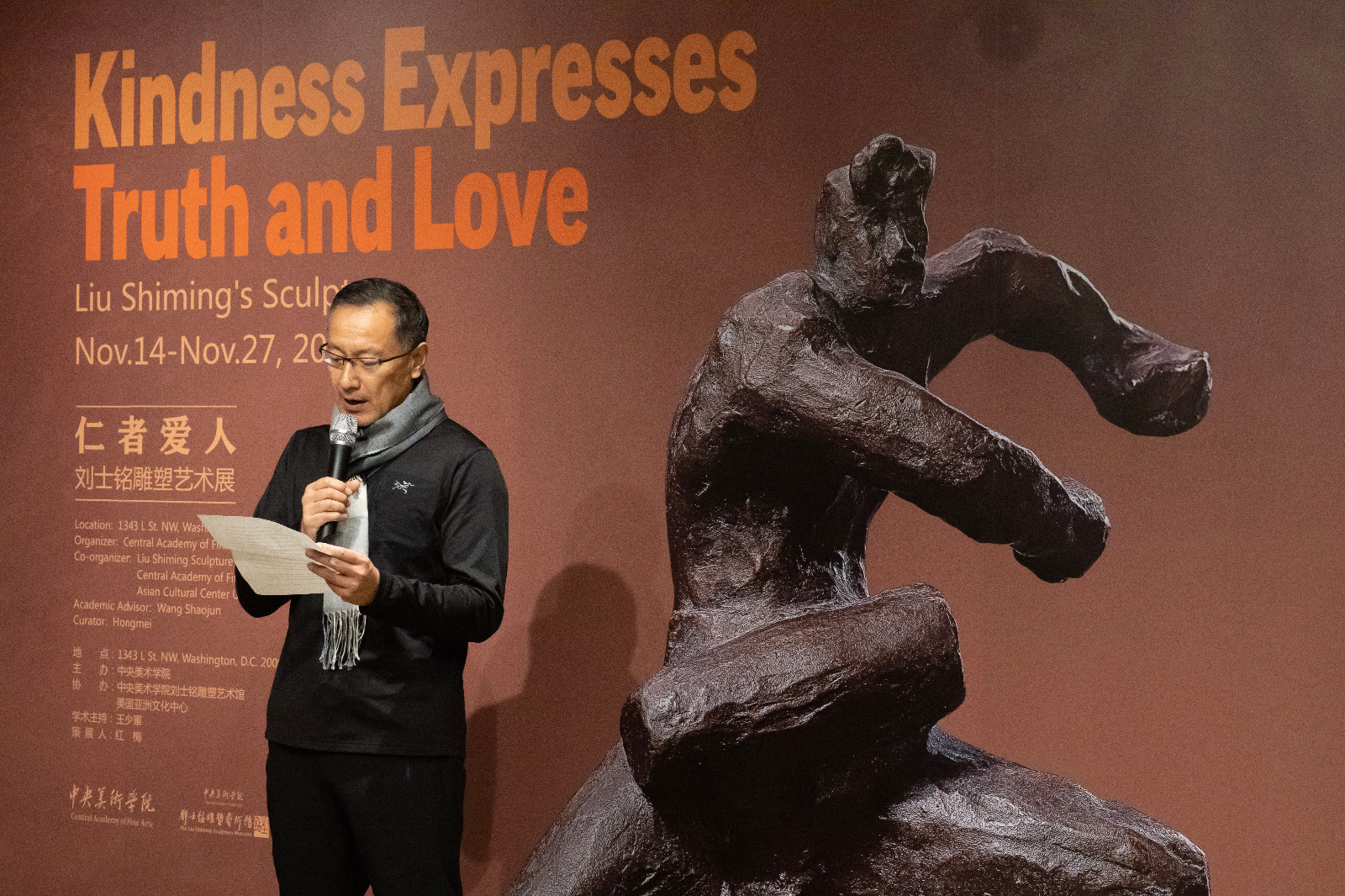
In his speech, Ma Lu, Dean of the School of Fine Arts of CAFA, said, “We call Mr. Liu Shiming a kind person because he has a kind heart. As an individual, there is always good and evil in nature. The good side of nature is the seed of a kind heart, which grows stronger and more powerful during Liu’s suffering, and generates a tenacious vitality that gradually matures his understanding of life. His nature, suffering, and vitality are the conditions that enable him to become a kind person and learn the ability to love people. The seed of a kind heart is a universal presence in everyone’s heart. The main difference between us is whether we can mobilize our energy to cope when faced with difficult and painful situations. One may not be able to resist the powerful external environment, so the most ideal state is to view the external undesirability as an inevitability under the present conditions. One shall not grumble but face it head-on, make sense of it, and use one’s own strength to solve it. Mr. Liu Shiming’s art is an expression of his love of life due to his near-death experience, and his ensuing love of people. It enables him to make subtle and extensive expressions of human kindness via his works, and make himself a kinder person.”

In her speech, Hongmei, the Curator of Liu Shiming International Sculpture Tour, said, “Through this exhibition, we hope the world could understand that the development of Chinese sculpture presents a modern narrative that is different from the Western one and transforms into modernity based on China’s traditional culture and localized experience. In this sense, Mr. Liu Shiming is a typical case. He is an important and unique sculptor in the history of modern Chinese sculpture. He is important because his sculpture is pioneering and innovative in the history of modern Chinese sculpture, with far-reaching influence. He is unique because he insists that ‘sculpture should be people-oriented, and art will lose its soul without people and humanistic spirit’.”

Li Min, Counselor and Deputy Chief Consul of the Embassy of the People’s Republic of China in the United States, said in his opening speech, “This year marks the 70th anniversary of the founding of the People’s Republic of China and the 40th anniversary of the establishment of diplomatic relations between China and the United States. It is of special significance to hold the touring exhibitions this year. Mr. Liu is the first generation of outstanding sculptors trained in New China and has created many exquisite works of art. The outstanding sculptures of Mr. Liu exhibited in Washington will definitely help strengthen the communication and cooperation between China and U.S. in the field of arts and culture, promote mutual understanding and deepen the friendship between the Chinese and American people.”
The exhibition also has a special DIY area for visitors, which invites the guests and the visitors to make sculptures by themselves.

Group Photo of Honored Guests (From right: Liu Wei, Liu Shiming’s son, Ma Lu, Dean of the School of Fine Arts of CAFA, Li Min, Counselor and Deputy Chief Consul of the Embassy of the People’s Republic of China in the United States, Hongmei, the curator, Wang Rong, Director of Asian Cultural Center in Washington D.C.)


Exhibition view

DIY activities
By Wang ChunyuanPhotographs by Asian Cultural Center


